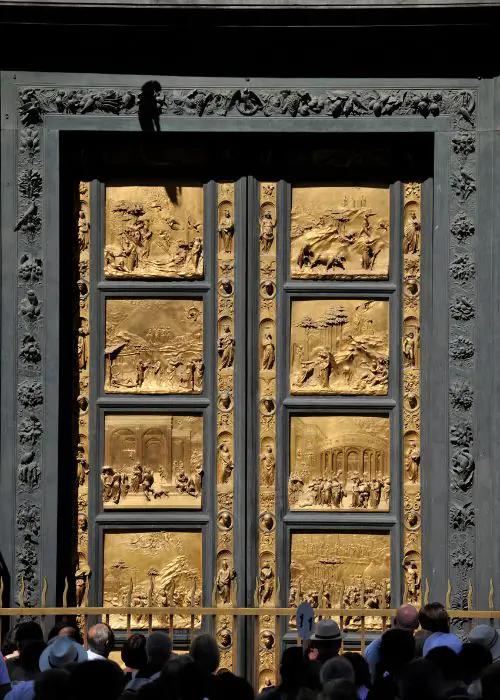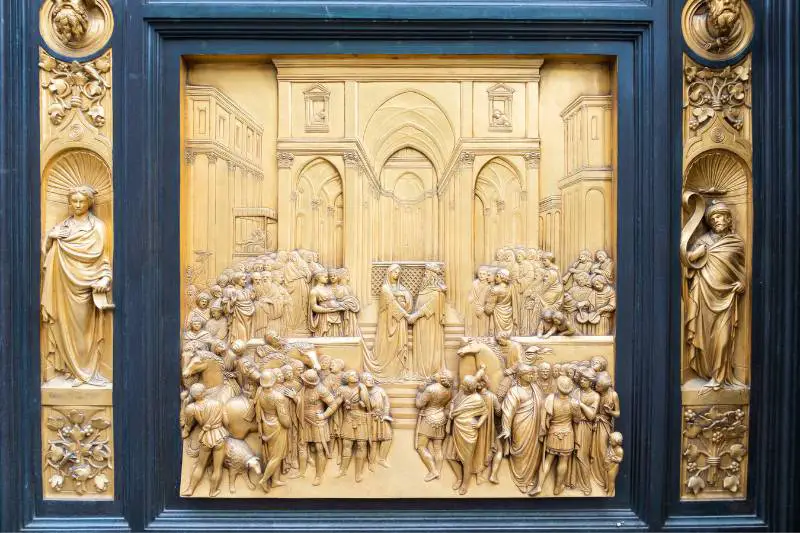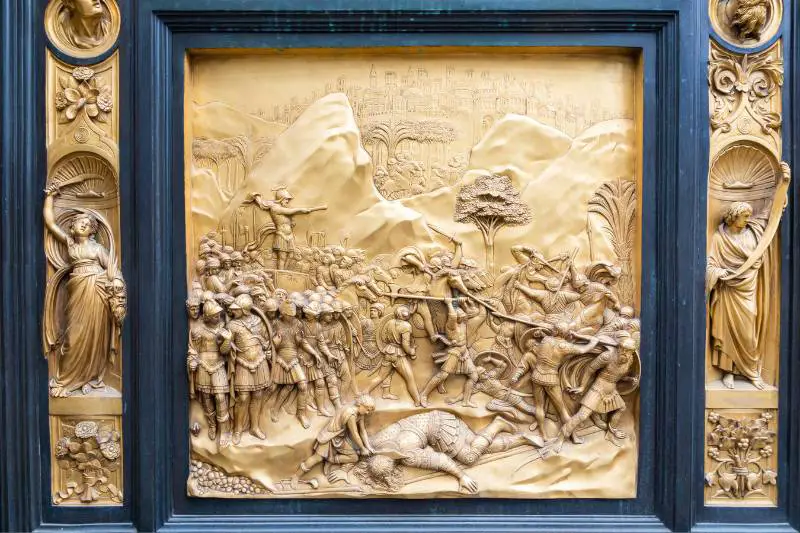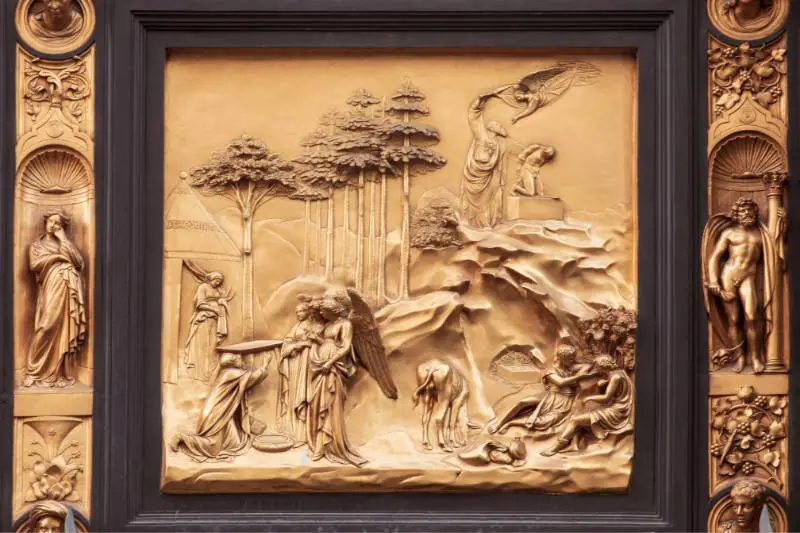Have you heard of the Gates of Paradise? In this article, we’re diving into the incredible story behind these breathtaking bronze doors of the Baptistery of Saint John in Florence. These doors are not just architectural feats; they are a pivotal chapter in the saga of art history, adorned with scenes that forever changed the course of Renaissance creativity.

I’ve always been fascinated by how art can tell stories, stories that are larger than life, transcending time and space. When I first laid eyes on the Gates of Paradise, it was like peering into a world where the boundaries between the divine and the earthly blur. The craftsmanship, the detail, and the history encapsulated in each panel piqued my curiosity—how could something made of bronze resonate so deeply with the human experience?
Crafted by Lorenzo Ghiberti over a span of 27 years, these doors represent not just an artistic achievement but a revolution in storytelling through art. They mix innovation, artistry, and drama in a way that hadn’t been seen before. And beneath their gleaming surface lies a rich tale of competition, innovation, and the human spirit. Let’s step closer and unfold the fascinating story behind what Michelangelo deemed worthy of being the gates of paradise.
Introduction to the Gates of Paradise
The Gates of Paradise adorn the Baptistery of Saint John in Florence. They are more than just doors; they are a gateway to the Renaissance’s soul.
Lorenzo Ghiberti created these bronze doors from 1425 to 1452. They represent a monumental shift in art and thought. They derived their name from Michelangelo’s remark, impressed by their heavenly beauty.

The Making of the Gates of Paradise
The genesis of the Gates of Paradise is a tale of artistry, innovation, and fierce competition.
In 1401, the Arte di Calimala (Cloth Importers Guild), one of the powerful guilds of Florence, announced a competition to design a pair of bronze doors for the city’s Baptistery. This competition attracted artists from across Italy, eager to showcase their skill and innovation. Among the competitors were Filippo Brunelleschi and Lorenzo Ghiberti, young artists who would later become pivotal figures of the Renaissance.
Ghiberti’s proposal for the doors was not merely innovative; it was revolutionary. He presented a panel depicting the Sacrifice of Isaac that was remarkable for its narrative clarity and dynamic composition. What set Ghiberti apart was his ability to blend technical prowess with a deep understanding of storytelling, creating scenes that were not only visually appealing but emotionally engaging.
His figures were not static; they were imbued with a sense of movement and drama that brought biblical stories to life in a way that had not been seen before.
His use of perspective and the careful arrangement of figures in space demonstrated an understanding of depth and realism that was groundbreaking. Ghiberti’s work on these panels showcased the early application of the principles of linear perspective, which would later be formalized by Brunelleschi. This innovative use of perspective was a key contribution to the aesthetic developments that characterized the Renaissance.
Moreover, Ghiberti was a master at utilizing the technique of lost-wax casting, allowing him to create panels with unprecedented levels of detail and delicacy. This technique involved making a wax model of the panel, covering it with a clay mold, and then melting away the wax to replace it with molten bronze. This process allowed for a level of precision and finesse in the final bronze panels that was extraordinary for the time.
Perhaps what truly distinguished the Gates of Paradise was Ghiberti’s visionary approach to the composition of the scenes. Rather than simply depicting isolated biblical moments, he intricately wove multiple narratives within a single panel, creating a rich tapestry of stories that invited viewers to engage with the art in a deeper, more contemplative manner. This narrative depth, combined with his technical innovations, earned the doors their nickname, “Gates of Paradise,” attributed to Michelangelo due to their unparalleled beauty and craftsmanship.

A Detailed Look at the Panels
Comprising 10 panels, each panel of the Gates of Paradise is a masterpiece in its own right, depicting scenes from the Old Testament with an intricacy and emotional depth that was unprecedented at the time.
Here, we delve into the content depicted in these panels, exploring the scenes that Ghiberti chose to immortalize in bronze.
1. Adam and Eve: This panel captures the poignant moment of the Fall, showcasing Adam and Eve in the Garden of Eden. Their expulsion is framed by the Archangel Michael, highlighting human vulnerability and the consequences of disobedience. The detailing of the figures and the flora around them reflects a deep observation of nature and human emotion.
2. Cain and Abel: Here, Ghiberti portrays two pivotal moments in the brothers’ story: the offering of their gifts to God and the tragic outcome of Cain’s jealousy. The juxtaposition of the fraternal relationship’s deterioration is set against a background that emphasizes the division between the divinely favored and the cursed.
3. Noah: This panel depicts the aftermath of the flood, with Noah’s sacrifice to God being a focal point. Surrounding scenes illustrate the ark and the release of the dove, symbolizing hope and God’s covenant with Noah. The careful arrangement of figures and animals in this narrative showcases Ghiberti’s innovative use of space.
4. Abraham: The binding of Isaac is the central theme, with Abraham shown at the moment of divine intervention. This dramatic scene emphasizes obedience and faith, with detailed expressions conveying the psychological intensity of the moment. Onlookers, including Sarah and Abraham’s servants, enrich the narrative complexity.
5. Jacob and Esau: This panel focuses on the complex familial relations and the pivotal moments of Jacob’s life, including the deceitful acquisition of Isaac’s blessing. The detailed rendering of the characters and their emotional depths sheds light on themes of rivalry, deception, and destiny.

6. Joseph: Ghiberti intricately narrates Joseph’s journey from his sale into slavery to his reunification with his family. The panel is filled with dynamic scenes that convey betrayal, forgiveness, and providence, emphasizing Joseph’s resilience and the fulfillment of God’s plan.
7. Moses: Detailing significant events like the Giving of the Law on Mount Sinai, the panel captures Moses as a conduit of divine will. Scenes of the Israelites, the golden calf, and Moses’ interactions with God are masterfully arranged to reflect the challenges of faith and leadership.
8. Joshua: Ghiberti presents the Battle of Jericho and the stopping of the Sun, showcasing divine intervention in human affairs. The depiction of movement and conflict highlights Renaissance interests in narrative and the human figure’s dynamism.
9. David and Goliath: This panel celebrates David’s triumph over Goliath, symbolizing the victory of faith and intellect over brute force. The scene is dynamically composed, with David’s youth and determination contrasted against Goliath’s downfall.
10. Solomon and the Queen of Sheba: The final panel illustrates the meeting between Solomon and the Queen of Sheba, a symbol of wisdom and the blessing of governance. The intricate details of the court and the figures reflect a deep respect for knowledge and the complexities of rule.
Through each panel of the Gates of Paradise, Ghiberti not only tells biblical stories but also explores themes of human emotion, divine interaction, and the importance of faith. His work marks a significant moment in art history, where biblical narratives were rendered with an unprecedented level of detail and emotional depth, heralding the full arrival of the Renaissance.

The Restoration Efforts
By the late 20th century, these doors had suffered significant deterioration. The restoration project, therefore, required a multi-disciplinary approach, combining the skills of conservators, chemists, and historians.
One of the main challenges involved in the restoration was the removal of centuries’ worth of grime and oxidation without damaging the delicate gold surface. This was achieved through the use of innovative laser technology, which allowed for precise cleaning without physical contact. Additionally, efforts were made to conserve what remained of the original gilding, a complex task given the thinness of the gold leaf and its vulnerability to damage.
Another significant challenge was the structural stabilization of the panels and frames to prevent future deterioration. This involved the careful balancing of environmental conditions, including humidity and temperature control, to ensure the long-term preservation of the doors.
The restoration of the Gates of Paradise stands as a testament to the dedication of conservators to preserving cultural heritage. It underscores the complex challenges involved in restoring ancient artworks, requiring not only technical skill and innovation but also a deep respect for historical and artistic integrity. The project not only brought back to life a masterpiece of Renaissance art but also advanced the field of art restoration itself.

The Gates’ Influence on Renaissance Art
The Gates of Paradise not only marked a pinnacle in Ghiberti’s career but also set a new standard for Renaissance art. Their influence extended far beyond their immediate visual appeal, inspiring artists and thinkers of the time, and contributing to the broader cultural movement that celebrated humanism and the rediscovery of classical antiquity. It marked the beginning of an era that valued artistic innovation and the intellectual skills of artists, contributing to the cultural environment that would foster the Renaissance.
The Gates of Paradise stand as a testament to the transformative power of art, at the intersection of technical mastery and artistic vision, heralding a new dawn for artistic expression. Through Ghiberti’s work, we witness the emergence of a new way of seeing the world, one that embraced realism, human emotion, and the beauty of the natural world, setting the stage for centuries of artistic exploration and discovery.
Visiting the Gates of Paradise

To witness the marvel of the Gates of Paradise, visitors should chart their way to the Florence Baptistery, standing proudly in the Piazza del Duomo of Florence, Italy. These splendid bronze doors, crafted by Lorenzo Ghiberti, encapsulate biblical stories with unrivaled craftsmanship. Due to their historical significance, the original panels are preserved in the Museo dell’Opera del Duomo for protection and the ones seen at the Baptistery are replicas.
Typically, the Baptistery is open to the public from 8:30am to 7:30pm. Entry tickets often include access to multiple sites within the Piazza del Duomo complex, providing a comprehensive experience of the area’s architectural and artistic heritage.
To ensure a smooth visit, booking tickets in advance is highly recommended. This not only helps in planning your day but also in skipping the long queues, which are common given the global interest in these masterpieces. Finally, consider hiring a guide or joining a guided tour for a deeper understanding of the history and artistry of the Gates of Paradise.
Click here for more information on visiting here.
As we close the door 😀 on our exploration of the world’s most jaw-dropping doors, it’s clear that these aren’t just entryways; they are masterpieces that hold stories, embody cultures, and inspire awe. Their intricate designs, historical significance, and architectural brilliance not only invite us into physical spaces but also into the rich tapestry of human creativity and ingenuity that spans centuries and continents.
Learn more about how Italians live in our story here that shatters all stereotypes. Read about the best places you can go in Italy to escape the crowds here. Find all our latest stories about Italy here.

